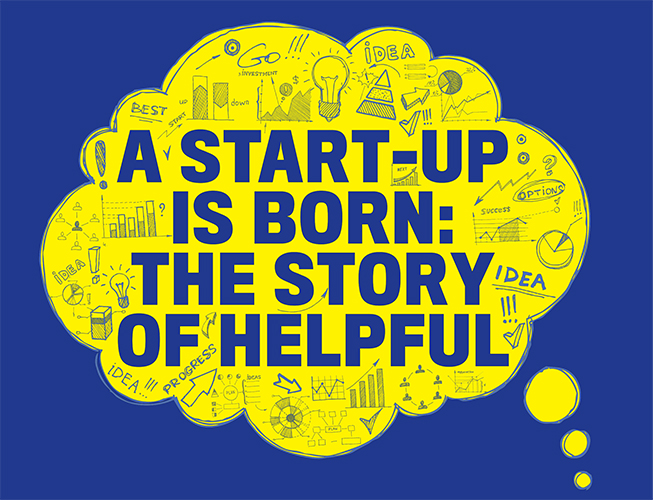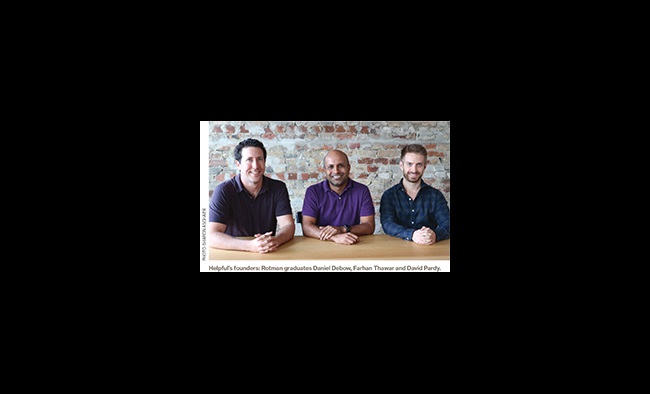
THE NEWS IS BOTH DISCOURAGING AND ENCOURAGING for today’s would-be entrepreneurs. First the bad news: Nine out of 10 start-ups fail. But, on the really bright side, as technology continues to evolve, virtually everything is open to better ways of doing things. As a result, PayPal co-founder Peter Thiel advises would-be entrepreneurs to ask a simple but powerful question: What valuable company is nobody building?
Of course, answering that question requires a lot of hard work. Just ask Daniel Debow (Rotman JD/MBA ’00).
Back in 2007, Debow was at the office sorting through his mail when he saw an invitation to yet another high-tech conference. Instead of tossing it in his circular file, he took the time to read the details: MESH (‘Canada’s Web Conference’) was to be held in Toronto, and it was aimed at people who wanted to connect with others who ‘are as excited about the potential of digital technology as you are’.
As one of the founding executives of Workbrain — the workforce-management software company that had just been sold for $227 million to U.S.-based Infor Global Solutions — Debow certainly fit the profile. At the time, he was eager to meet top local talent to work with him on his next venture — so he signed up.
What he couldn’t have known in advance was that he would meet his future business partner at that conference.
Debow’s own appetite for entrepreneurship had been whetted years earlier. In 2000, while he was studying for his JD/MBA at the Rotman School of Management, his best friend’s older brother, serial entrepreneur David Ossip, gave him an opportunity to work with him on Workbrain, which he founded. Debow and fellow classmate Matthew Chapman (Rotman MBA ’00) wrote the initial business plan for Workbrain while they were still students.
At the MESH Conference, Debow was in his element. He met lots of smart and interesting people that day and, in a case of serendipity, one of them was Farhan Thawar (Rotman MBA ‘07) — a part-time Rotman MBA student who also held a Math degree from the University of Waterloo and had already held senior positions at Microsoft and Celestica.
Thawar told Debow about his current role at Microsoft, where he created and ran the most advanced search-relevance lab outside of Redmond, Washington. He explained how he supported the roll-out of new features and bug fixes for 18 million Canadians on the Finance, Automotive, Entertainment, Video, Search and Homepage channels.
Debow was suitably impressed: He wanted to hire Thawar on the spot to work with him on his next venture. “Farhan was clearly the best engineering leader in Toronto,” he says. While Thawar was interested, the timing just wasn’t right, so the two promised to stay in touch and work together on a start-up someday.
Later that same year, Debow co-founded Rypple — a social performance management platform — with his former Workbrain colleague David Stein and George Babu (Rotman JD/MBA ‘09). When they met, Babu was still a Rotman student who was eager to get to work on a start-up. As Debow tells it, Babu just began ‘showing up’ at the as-yet-unnamed start-up’s office after class — leading Stein to ask Debow one day, “Does this guy work for us?” Soon enough, he did; and a few short years later, in 2012, the trio sold Rypple for $65 million to Salesforce.com.
Babu went on to co-found Kindred — whose mission is to build machines with human-like intelligence — along with Rotman Professor Ajay Agrawal; while Stein founded Leaders Fund, a firm that invests in fast-growing enterprise software companies. Debow took on a role at Salesforce, working to integrate the company with Rypple. Once it was transformed into Work.com and repositioned as a sales-performance tool, he took on a new challenge for the company: Using the Salesforce platform to build ‘wearable apps’.
Meanwhile, Thawar left Microsoft in 2008 to become Chief Software Architect at Achievers; helped start Canada’s first y-Combinator-style incubator, Extreme Venture Partners, which funded eight companies in three years; and then served as VP of Engineering at mobile-development firm Xtreme Labs — which he helped to scale from 10 to 250 people, building some of the world’s most popular mobile apps. The firm was acquired in 2013 by U.S. software development consulting firm Pivotal Software, and Thawar accepted the role of Chief Technology Officer, Mobile, at Pivotal.
All of this time, Debow and Thawar stayed in touch, and by late 2015, the timing was finally right: The two were ready to work together. They rented a small office near St. Clair Avenue and Bathurst Street — midway between both of their homes — and set up shop to devise their next venture. Right around that time, serendipity struck again: Debow was back at the University of Toronto, speaking to the JD/MBA Students Association, when he met David Pardy (Rotman JD/MBA ‘16).
Pardy — who also holds a BSc in Physics and Math from Queen’s and a Certificate in General Management from Stanford — told Debow of his keen interest in joining a growth startup. Debow invited him to informally assist with his new venture and — impressed with his bright ideas and drive — he and Thawar brought Pardy on board as an official co-founder of their yet-to-be-defined company.
With a founding team in place, the hard work began in earnest for the three Rotman graduates.
“Our process was deeply influenced by [former Rotman School Dean] Roger Martin’s thinking — as well as by Four Steps to an Epiphany by Steve Blank and The Lean Start-up by Eric Ries,” says Debow.
Following Martin’s advice from Playing to Win, the trio began by deciding ‘Where to play’. They created an initial filter for their ideas by asking, ‘What do we want to achieve?’ and ‘Where do we want to spend our time?’ They knew, for instance, that they didn’t want to build a car parts factory. “We wanted to create something that would make everyday life easier and more productive for as many people as possible. And, to paraphrase Wayne Gretzky, we weren’t interested in where the hockey puck was, but in where it was going to be.”
Their shortlisted ideas included a free, for-profit university; a home maintenance service; a LinkedIn-style networking platform for blue-collar workers; and a super-intelligent AI-powered employee directory.
“For each idea, we used Roger’s approach by asking, ‘For this to be successful, what four or five things have to be true?’” The team worked through each idea, posing that question and coming up with what amounted to a series of hypotheses — a list of things that had to be true for the idea to be a winner. Next, they
ranked each hypothesis, from ‘easiest to disprove’ to ‘hardest to disprove’. If one of the ‘proof points’ was very unlikely to ever happen, that idea was discarded.
“Our focus was very much on, ‘What can we dis-prove the validity of?,’” says Debow. “We were actively trying to prove ourselves wrong. And if we couldn’t — if all the things that ‘had to be true’ were indeed plausible — we kept that idea alive.” For the ideas that made it through to that critical stage, the team built rough prototypes and tested them out with people to gain critical feedback and iterate to improve them.
Ultimately, they settled on the idea for an AI-powered employee directory that would enable people across an organization to know what their colleagues were working on, and how that work was progressing, in real time. “When we tested the prototype, users and CEOs alike told us, ‘We need this tool: You should go ahead and produce it.’”
As indicated, the team didn’t do much traditional market research. “We were largely guided by our intuition about what we felt was a really big problem for lots and lots of organizations: employee knowledge sharing. We had experienced this ‘pain point’ ourselves — and lots of people told us they felt it, too.”
The group worked for nine solid months on the employee directory idea. But all of a sudden, something just didn’t feel right. Instead of ignoring it and marching ahead, the founders decided to put the project on hold for a while and clear their heads. They instructed their employees to spend an entire week working on whatever they wanted to work on.
The risk paid off. Two of their employees came up with a promising concept, related to the initial idea: A mobile app that would enable employees to send each other short videos to share information about their work — sort of like ‘video voicemail’.
Over the next few weeks, the entire team tested the prototype. “Many of us were away from the office, travelling for meetings, and we found that when we used this tool, we felt closer to our colleagues and more connected to them. We just didn’t feel that usual pain point of being separated from our team.”
Not to mention, they didn’t have to write as many long emails to each other, which was an added bonus — and led to less misinterpreting of the tone and content of their email messages.
“The three of us looked at each other one day and said, ‘This is even better than our original idea.’”

The trio made the tough decision to pivot and change their focus. And it wasn’t all based on gut instinct: Based on their earlier research, they knew that employee engagement is a huge pain point for today’s organizations. According to Gallup, fully 70 per cent of employees are not engaged with their work. Several other
pieces of data encouraged their decision: Video content is expected to account for 75 per cent of the world’s mobile data traffic by 2020; by 2022, mobile workers will account for 42 per cent of the global workforce; and every single day, people send billions of video messages through Snapchat, Instagram and Facetime.
To date, most of the user and app-development activity in video messaging had occurred in the consumer space; but the team felt strongly that the enterprise space was next. Lots of workplaces were already using Skype and Google hangouts; but this app would be different. Those tools are what is known as ‘synchronous communication’ tools: You have to be there, at your computer or device, at the same time as the people you are communicating with. This product would be ‘asynchronous’ — so that users could send a short video message at any time of day to their colleagues.
“We saw all these different proof points — a constellation of them — and we just inherently knew that ‘this is going to happen at work.’ Every organization needs tools that foster more humane and effective communication.”
The name for their company: Helpful. Debow explains: “It sounds simple, but the whole reason we wanted to build this company in the first place was to be helpful to as many people as possible; we also felt that this tool would lead to a much more helpful workplace culture — where people would communicate and share information more often.”
Marshall McLuhan famously said ‘the medium is the message’, and Debow feels that holds true with Helpful. “What McLuhan meant is that the form of a medium embeds itself in any message that it transmits, so that the medium influences how the message is perceived. If you want to engage people, you need to use an engaging, authentic, human medium.” Video messaging — with its ability to convey deeper meaning through facial expression, body language, tone of voice and inflection — can significantly improve the most important aspect of successful businesses: Relationships with and between employees.
Available on the Apple and Google Play stores since the start of 2017, Helpful is already being used by major airlines, banks, grocery chains, tech and creative agencies, and, of course, lots of start-ups. The team is continuing to enhance its features, functionality and user interface.
If you want to engage people, you need to use an authentic, human medium.
Along the way, Helpful’s founders have worked with the Rotman School’s Creative Destruction Lab (CDL) — the seed-stage program for science-based companies that Debow helped to establish in 2012. Through the CDL, Helpful’s leaders have been able to network with top technology innovators and researchers affiliated with the Lab — and to put together a powerful team of advisors that includes Microsoft Bing co-creator Barney Pell; director of Apple AI, Ruslan Salakhutdinov; Bloomberg Beta partner Shivon Zilis; and Richard Zemel, who built the University of Toronto’s Machine Learning Lab.
The insights that Helpful’s founders have gained about AI helped them build a speech-recognition capacity for their app that transcribes video messages — a feature they consider a key differentiator between their product and others on the market.
“There are times when you want to send an expressive message to someone, but that person is not in a position to listen to audio. But, if you have to type out the message, that is extra work. We wondered, ‘Could we use advances in machine learning to do that typing?’ It turned out that we could. We added this to the app, and it made the experience that much better,” Thawar says.
A startup isn’t a ‘company’ in the typical way people think about it, says Debow. “It’s more of a learning machine.” About 80 per cent of the original code for the app was changed along the way, as they iterated the product. At each of his ventures to date, he has either partnered with or hired graduates of the Rotman
School, which he calls ‘an incredible talent magnet.’ Helpful’s backstory not only reflects the talent, ingenuity and grit of its founders — it is a testament to the Rotman School’s capacity to nurture graduates who are interested in veering off the beaten path of consulting or banking to start their own companies.
Helpful is currently free to use, and the company will eventually charge a fee for a premium version. The founders say their vision is to not only create a great product that is used and loved by millions, but to more broadly create many high-quality jobs, strengthen Canada’s technology sector and contribute to the country’s economic prosperity. Noble goals, to be sure. “We have in our hands something that I want to use all the time,” says Debow. “It has transformed how my colleagues and I work with each other.”
Some people still believe success has a lot to do with luck; but when you dig into the details, it becomes clear that most successful people ‘make’ their own luck. They learn how to put themselves in the right situations, grasp opportunities as they arise, allow for randomness, take risks — and most importantly, they work really hard. Helpful’s founders are a case in point. And clearly, their Rotman degrees didn’t hurt, either.
Further Reading:
Article: "The Entrepreneurial Mindset @ Work" by Farhan Thawar, available in the Winter 2018 issue of Rotman Management magazine.
This article appeared in the Winter 2018 issue. Published by the University of Toronto’s Rotman School of Management, Rotman Management explores themes of interest to leaders, innovators and entrepreneurs.
Share this article: